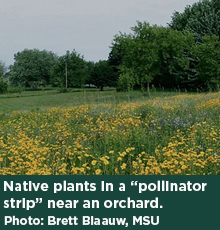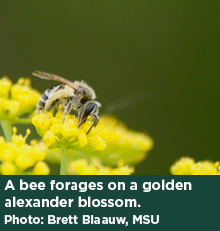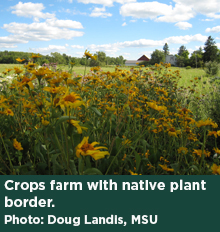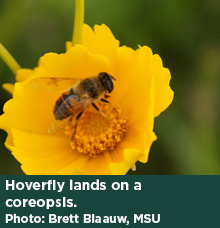Uses for Agriculture
Native non-crop plants can provide habitat for pollinators and natural enemies and also protect the health of our waterways.
 Pollinator strips
Pollinator strips
Over 70 percent of our agricultural crops are bee-pollinated with a third of our food being dependent on pollination. This vital provisioning ecosystem service can be sustained by plantings of habitat including native flowering plants and shrubs, which provide pollen and nectar throughout the growing season as well as undisturbed habitat for bee nesting. Choose native plants from our regional plant list for Michigan.
Natural enemy habitats
Insect predators and parasites, known as natural enemies, can control pest populations in agricultural crops (biological control). Natural enemies are more likely to thrive in undisturbed areas that provide overwintering habitat, flowers to support their survival and reproduction, and refuge from pesticide applications in crops. Natural enemy populations can then control pest populations in nearby crop fields or other plantings. Natural enemies may be conserved with the same plantings that support pollinators.
Conservation areas and riparian buffers
There are already programs in place through the Natural Resources Conservation Service and other organizations to support non-crop plantings that conserve soil, reduce pollution and provide wildlife habitat in farming landscapes. These areas are often called conservation plantings if they are in previously farmed crop lands. For example, areas planted to native species along waterways can provide important ecosystem services of assisting in water filtration and preventing flooding, as well as providing habitat for wildlife.
Bioenergy crops
Fast growing native perennials have several advantages as bioenergy crops. Many store carbon below ground in their roots helping to reduce greenhouse gasses and can support populations of beneficial natural enemies and pollinators. The aboveground biomass can be harvested and burned to produce cleaner electricity or processed into biofuels to partially replace gasoline.






 Print
Print Email
Email